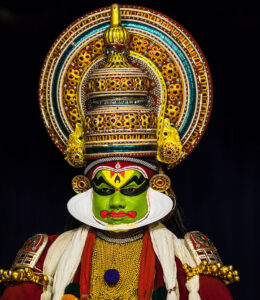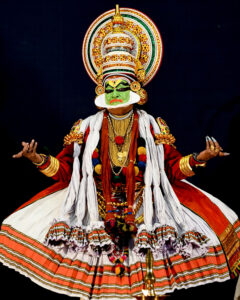 Intertwined with myths and history, the divine and the common, Kathakali is a performance of grandeur, glamour and intricacy. It is an art form, maybe even universally linked to Kerala, as the elaborate makeup and costumes and dramatic facial expressions might come to our minds when thinking about the state. The origin of the art form is associated with an interesting story. The story goes that the Raja of Kottarakara (an old province in erstwhile Kerala) had asked the dignitaries of Calicut for a troupe of Krishnanaattam (the Play of Krishna), as it was quite popular in the Malabar region but was refused. The miffed king prayed to the gods for revenge and they appeared in his dreams to teach him the dance-drama Kathakali (Play of Stories). Kathakali performances are usually mythological stories from the puranas and other Hindu sacred texts.
Intertwined with myths and history, the divine and the common, Kathakali is a performance of grandeur, glamour and intricacy. It is an art form, maybe even universally linked to Kerala, as the elaborate makeup and costumes and dramatic facial expressions might come to our minds when thinking about the state. The origin of the art form is associated with an interesting story. The story goes that the Raja of Kottarakara (an old province in erstwhile Kerala) had asked the dignitaries of Calicut for a troupe of Krishnanaattam (the Play of Krishna), as it was quite popular in the Malabar region but was refused. The miffed king prayed to the gods for revenge and they appeared in his dreams to teach him the dance-drama Kathakali (Play of Stories). Kathakali performances are usually mythological stories from the puranas and other Hindu sacred texts.

As the stories being performed aren’t anything new to the audience, what captivates them would be the vibrancy of the actors’ appearance and their performance itself. Like in many art forms around the world, the use of costumes and make-up is significant in Kathakali. The substances used for masking the face are natural elements – powdered mineral stones, coconut oil, rice flour paste, etc. The differently coloured faces one would see during a Kathakali performance are not random. With popping and distinct colours, the actors mask their faces with the personalities of the characters they are portraying. These faces are a window to the nature of these mythological characters – demon king Ravana, devoted Hanuman, godly Krishna, dutiful Jatayu, and so on.
The different make-up types can be largely classified into 7 categories. The most familiar would be pachcha or green. Green faces usually denote divine figures like Vishnu, Krishna, Yudhishitira, Bhima, Arjuna, etc. These characters are morally upright and possess a calm composure, hence considered to be among the most refined male roles in the art form. Secondly, pazhuppu (ripe) are also for divine characters, four in particular. Here, green is replaced with the colour of ripened fruits – orange-red. This face is worn by Balarama, Brahma, Shiva and Surya. It is to be noted that these colors are only the base and further work is done on the actors’ faces. Eyebrows and eyes are defined with black colour, lips painted in sharp coral red and often a white outer frame on the jawline is set. There are even stylized marks to further set apart certain characters, like red and black markings on a yellow base for Vishnu and the third eye for Shiva.
Kathi, or knife, refers to the distinctive moustache on these characters. Their faces are done similarly to that of pachcha but also include an upturned red moustache framed by white. This pattern is also repeated by stark red and white markings above the eyes and eyebrows. These characters, one of the most famous being Ravana, are usually high-born nobility, possessing some divine features, and set apart from the godly due to their arrogance and evil nature. There are also two white protrusions on their nose and forehead.
 The next category, thadi, means beard, and as the name suggests, the nature of the characters is portrayed through different beards. Vella thadi, or the white beard, shows somebody of divine nature, the Hanuman getup being the most well-known. The chuvanna thadi or red beard, is generally a vile and vicious characters like that of Dushasanna from Mahabharata. Eyes enveloped in black, white moustache extending up to ears, black lips, and large protrusions on nose and forehead, chuvanna thadi actors appear with a sizeable red beard. The karutha thadi or as the name translates black beard, are also evil but more connected to nature. The face is quite similar to that of chuvanna thadi; just that the red is substituted by black. They are primal beings, living lives closely related to nature and forests, and a stylized flower appears on their nose.
The next category, thadi, means beard, and as the name suggests, the nature of the characters is portrayed through different beards. Vella thadi, or the white beard, shows somebody of divine nature, the Hanuman getup being the most well-known. The chuvanna thadi or red beard, is generally a vile and vicious characters like that of Dushasanna from Mahabharata. Eyes enveloped in black, white moustache extending up to ears, black lips, and large protrusions on nose and forehead, chuvanna thadi actors appear with a sizeable red beard. The karutha thadi or as the name translates black beard, are also evil but more connected to nature. The face is quite similar to that of chuvanna thadi; just that the red is substituted by black. They are primal beings, living lives closely related to nature and forests, and a stylized flower appears on their nose.
Kari or black can be considered to be the most monstrous characters in Kathakali. They are the demonesses and other such beings that appear with black faces, patches of red outlines in white, and dotted white patterns, alluding to smallpox. Their black faces are a sharp contrast to minukku, or radiant. These are pious and idealised females like Sita or Draupadi or spiritually perfected males like brahmans; their faces are set in warm yellow orange and hence appear to be shining. The last category, teppu can be considered as a special umbrella term to encompass other characters that appear in different stories in a distinctively stylized manner. Bird-like make-up of Jatayu or Garuda, the half man-half lion get up of Narasimha, and Bhadrakali with a red tongue and pockmarked face being a few of them.

On these bases of green, red, black or orange as seen above, further marks are added a patch of red on a green face, maybe some green on a black face. Though there can be gods and idealised men and women in their green and orange make-up, these Kathakali faces show us that people are usually a combination of varying traits. As the dance drama showcases the intricate nature of humans through tales of gods and demons, the masked faces also seem to reveal the complexity of our mortal disposition, a life of pachcha and kari and everything in between.

